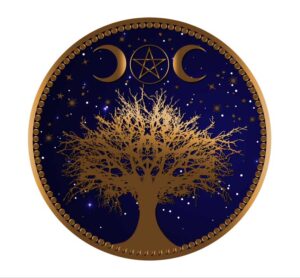May 23 is the full moon of the Anglo-Saxon month Þrimilcemōnaþ, which literally translates as “three milkings,” as it was said at this time of year female livestock produce extra mix. This time of year reminds us of the wondrous abundance of mother earth. Early farmers maintained that cows could be milked three times a day during this season.
The Starry Lady & the Man in the Moon

It seems, at times, that the connection of the Sun with the masculine and the Moon with the feminine is a concept so common it is universal. In the western world, this really is just another Roman contagion. Though the connection extends back into Greco-Roman antiquity, with possible roots in ancient Syria, it is really the Roman Sol from which it descends to us. Much of what is now being examined in a critical manner—the compulsion to war and conquest, empire-building, colonialism, and “manifest destiny”—are rooted in the insidious glorification of the Roman Empire.
Until recently, historians have taught us that Rome brought civilization and peace, the Pax Romana, to the barbarian territories. My copy of the Oxford Illustrated History of Britain (1984) begins with Claudius’s first-century conquest of southern Britain. Was there no culture before their arrival? Of course, there was. The Romans brought roads? No, those were there long before even Julius turned his eyes toward the Isles. Instead, they brought their culture of imperial authority, bureaucracy, and a hegemony of the elite.
The Roman sun god, Sol, Sol Invictus in the later empire, was akin to the state god of the empire. His temples existed in the city of Rome back to the time of the Republic. He personified glory, power, and victory.
What often goes unnoticed is a deeper, ancient conception of the Sun being female. This was not just a belief in Norse mythical cosmology, but also in Anglo-Saxon heathenry. These alternative perspectives, with their roots in our ancient past, offer a fascinating counterpoint to the more commonly known Roman association of the Sun with masculinity.
Now to bring this forward to my own working relationship with the worlds… The Sun is the Mother. Our Sun is, for us at least, the first among the stars that form the splendor of her body arched across the sky. She is also the earth beneath our feet. Her presence is all around us. As above, so below.
I find her presence so potent and ever-present that it borders on the ineffable. Are there truly words that can contain the universally present? Her promise is our prosperity. At this time, when she emerges from her rest during winter, flowers begin blooming, fruit trees bud and mother’s milk is in abundance.
The Moon is her son. His reflection of her light reminds us of her presence even in the dark of night. He is the Holy Covenant, the divine promise, of the still moment between order and chaos.
Celestial Alignments and the Wheel of the Year
The Pueblo peoples of the southwestern United States were known for their advanced understanding of astronomy and their ability to align their kivas – underground ceremonial chambers – with celestial events. One such event was the equinox, which occurs twice a year when the plane of the Earth’s equator passes through the center of the sun, resulting in equal amounts of daylight and darkness. The Pueblo peoples believed that this was a time of balance and harmony, and they honored it with special ceremonies.
The Pueblo peoples’ method of aligning their kivas with the equinox was a testament to their unique approach. They would meticulously track the sun’s movement throughout the year, noting its position at various times of the day. This data was then used to design their kivas in such a way that a beam of light would enter through a small opening in the roof and illuminate a specific spot on the floor during the equinox.
The alignment of the kiva with the equinox was not merely a practical matter for the Pueblo people but a deeply spiritual one. They believed that the equinox was a time of harmony between the physical and spiritual worlds and that the alignment of the kiva with this celestial event enhanced this connection. The equinox was a time for prayer, reflection, and renewal, when they sought guidance and wisdom from the spiritual forces, they believed were present.
The Neolithic people of Britain were also masterful builders and engineers, and they left behind a legacy of impressive monuments that still fascinate and intrigue us today. One of the most striking features of these monuments is their alignment with the sun, particularly at the solstices – the points in the year when the sun reaches its highest or lowest point in the sky.
Many of these neolithic sites, such as Stonehenge, Avebury, and Callanish, are aligned with the solstices in some way. At Stonehenge, for example, the main axis of the monument is aligned with the direction of the midsummer sunrise and midwinter sunset. On the day of the summer solstice, the rising sun shines directly through the entrance of the monument and illuminates the central altar stone.
The Neolithic people’s ability to align their monuments with the sun’s movements is a testament to their advanced understanding of astronomy and their deep reverence for the natural world. They observed the sun and stars over many years, noting their seasonal changes, and used this knowledge to create structures that harmonized with the earth’s rhythms. This enduring legacy of astronomical knowledge is a testament to their ingenuity and respect for the natural world.
These solstice alignments were not just practical considerations, however. They were also imbued with deep spiritual significance. The Neolithic people, it seems, believed that the solstices were times of great power and magic when the veil between the physical and spiritual worlds was thin. They would use these times for ritual and celebration, seeking to connect with the forces of nature and the divine
